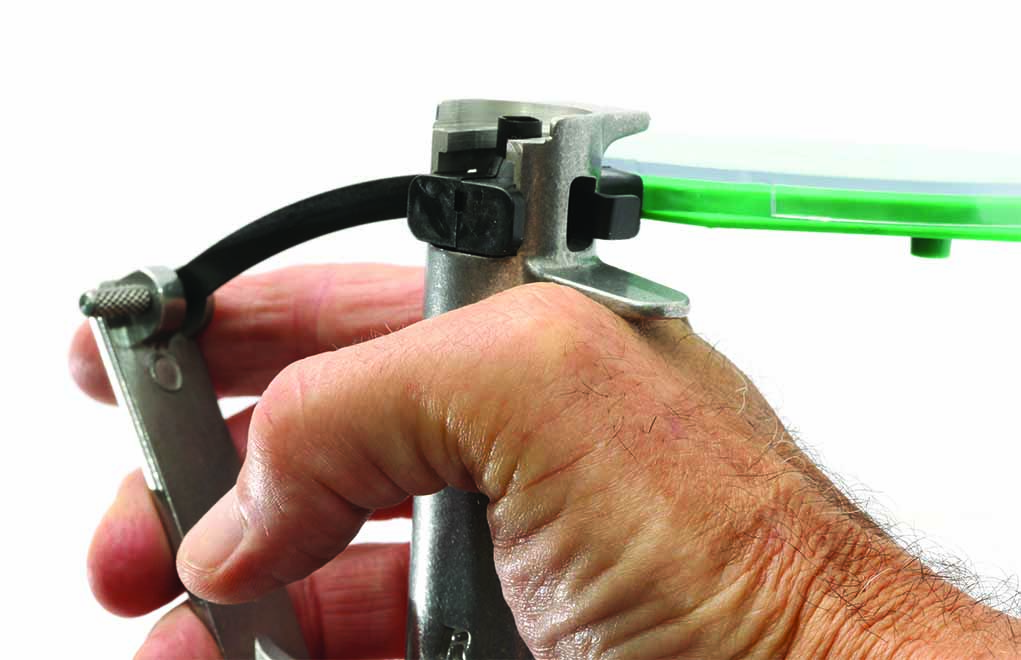
hand-priming system does not come with a shell holder, so be sure you include one in your order.
Seating primers by hand is time consuming, sometimes arduous and a must for building those rounds that really matter.
There’s a phrase the British use: “Horses for courses.” This means you select the tool for the job and not figure out a way to make the (perhaps not entirely suitable) tool you already have do the work that needs be done.
When it comes to priming cases, every reloading press made comes with an adapter to seat primers. This is an interesting situation: You have a 2-foot steel handle onto which you can throw your entire body weight as a lever to seat a pressure-sensitive item that weighs the smallest fraction of an ounce. Those who use this method have to learn a particular sensitivity to the feedback the operation provides them—and put up with a few mangled and even detonated primers as they learn the limits.
Or, you can go with something that has less leverage and more sensitivity.
Here’s The Right Tool
The RCBS hand priming device is just such a tool. It has a tray onto which you can slide an entire sleeve of primers—100 in all—so you don’t risk handling them, dropping them and getting body oil and sweat onto them, possibly causing problems.
The process is simple: You assemble the primer system with either a large or small primer adapter and seating rod. You install a shell holder appropriate for the caliber you are seating. You then slide on the tray of primers, close the lid and get to work.
Tilting your hand allows you to slide one primer at a time into the feed system, install a case, seat and then repeat.
However, There Are Limits
First of all, you have to have a shell holder for each caliber you want to seat primers in. Luckily, this isn’t a big deal. Shell holders are $10 to $12 each, and one size fits many. If, for example, you buy the shell holder for a .30-06, it will work for any case that has the same rim diameter; you know—all the usual suspects. Second, your brass has to already be cleaned, sized, de-primed, trimmed (if it’s a caliber that needs trimming) and ready to load.
This isn’t much of a problem, because you’ll have to have done all this to your brass anyway for any other priming system. It’s a tad slow, but it’s precise and allows for great sensitivity in seating.
Load Up On Reloading Info:
OK, a bit of a confession here: I use this setup only for some reloading, not all. On my progressive presses, primer seating happens as part of the loading process. So, I feed clean brass in and let the press do the sizing, de-priming, seat primers as the case moves along and finish with powder, bullet and crimp. Most of my ammo for most of my shooting is loaded this way.
Great For Sensitive Seating
I did use the RCBS (and other, earlier systems) for sensitive primer seating—specifically, revolvers with tuned actions. When a DA revolver has the action slicked up and lightened to the point that factory primers become a bit uncertain to ignite, you have to go to extra lengths. Consequently, I would change the reloading process for my competition ammunition.

This was for .45 ACP, but the process would work fine for other calibers. I’d clean the brass as squeaky-clean as I could and then used a special toolhead setup to just resize and deprime. Then, I’d tumble the de-primed brass to clean out the primer pockets. Why? Because if I’m going to do all this work, I want to get as much benefit as possible, that’s why.
I’d inspect the cases after the second cleaning to make sure there were no primer flash holes with tumbling media caught in there (there was always some). Then, I’d hand-seat primers, making sure they were fully seated and at the optimal sensitivity.
Finally, they’d be run through another toolhead setup with a sizing die lacking a decapping pin and no primers in the primer feed system. They’d be sized (not that they needed it) and then get powder in the already-primed cases, bullet and crimp.
Yes, Yes … And Yes
Was it a lot of work? Did it take extra time? Was it worth it?
Well, the two team gold medals from IPSC World Shoots resting on the counter in my office would say, “Yes.”
All my practice ammo was loaded the regular way for most of the shooting. But when it came time to load the match ammo and the practice ammo with the match trigger-setting tune-up a couple of weeks before a Nationals or the World Shoot, that ammo was loaded the second way.
If you are loading experimental ammo and want to decrease the weight of variables, hand-seating primers will help there. To get the greatest sensitivity and consistency in match ammo, hand-seating works.
If you want volume, you have to settle for a certain amount of “common denominator” in primer seating consistency—a lot of time, but that’s just fine. For the rest of the time, there’s the RCBS hand priming tool.
The article originally appeared in the November 2019 issue of Gun Digest the Magazine.
 NEXT STEP: Download Your Free Storm Tactical Printable Target Pack
NEXT STEP: Download Your Free Storm Tactical Printable Target Pack
62 Printable MOA Targets with DOT Drills – Rifle Range in YARDS This impressive target pack from our friends at Storm Tactical contains 62 printable targets for rifle and handgun range use. Target grids and bullseye sizes are in MOA. Ideal for long-range shooting! Get Free Targets

